People generally don’t expect to see small dogs hiking so I find they have a lot of questions.
I don’t mind answering. I’ve been hiking with my Dachshunds for 15 years and I’m passionate about opening people’s minds to the idea of small dogs as hiking companions.
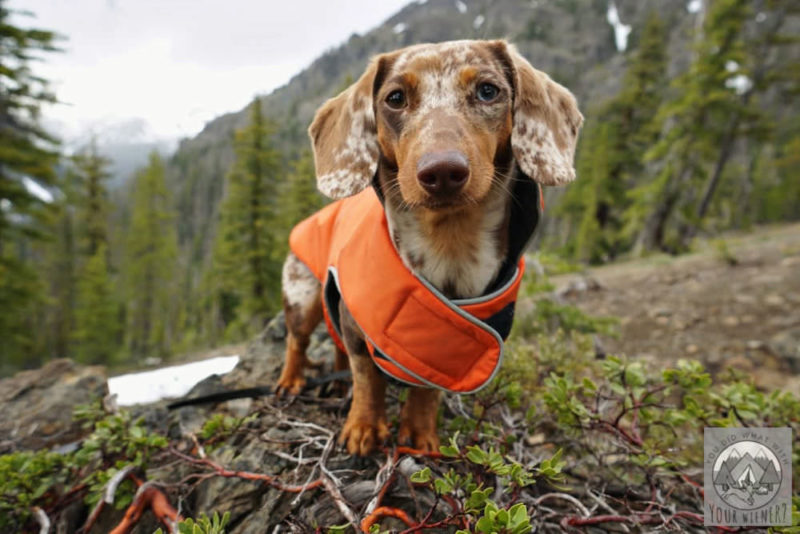


I compiled a list of common questions I’ve received from our blog readers and social media followers over time. I figured if one person had the question, other people were wondering too.
Except for a few minor edits for clarity and grammar, the questions are unchanged.
For a few of them, I was asked several different ways about the same topic. I either chose the question that was the most detailed or combined my answer from two different questions.
Q: “Can I start hiking with my 11 week old? Are short hikes and carrying her when she gets tired ok?”
Unfortunately, no. That’s too early. Her bones and joints need to properly develop first.
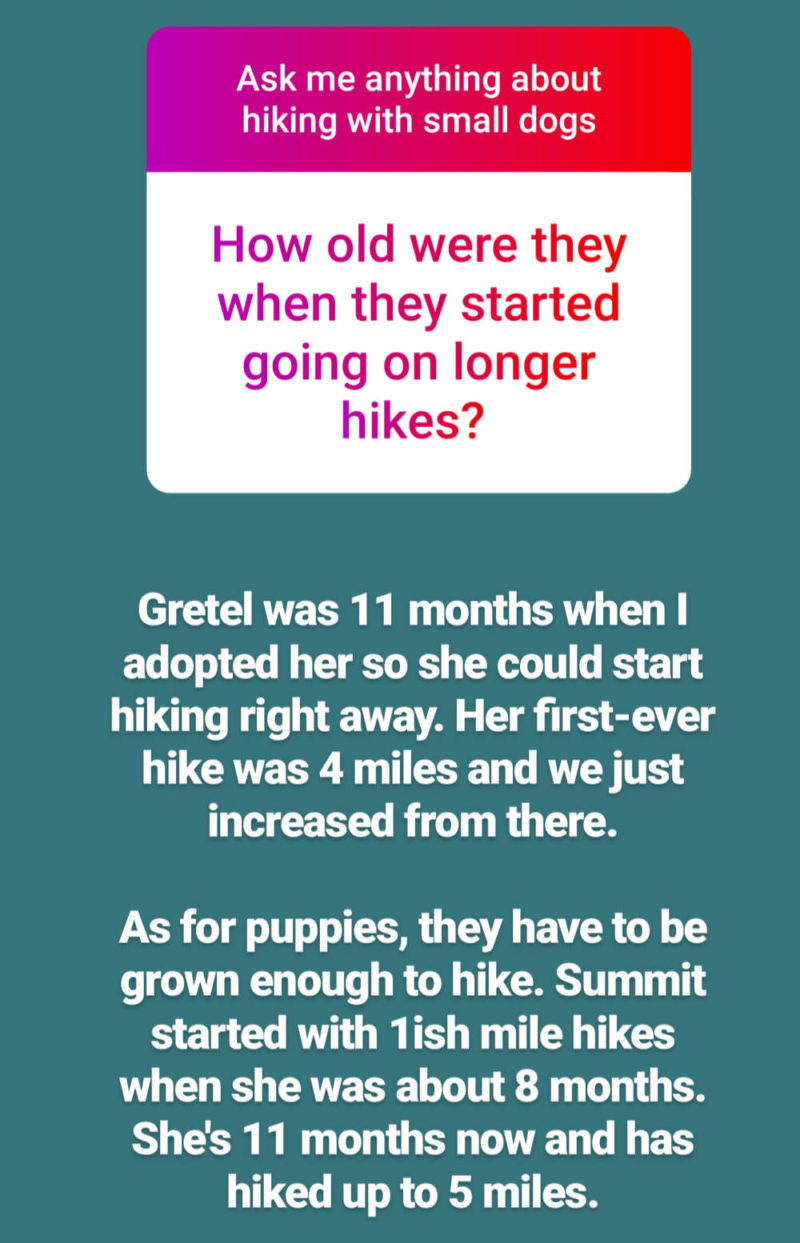


For more information, read my blog post “How Old Should My Puppy Be Before They Hike?“
Q: “How to Start? Any Tips?”
Some general tips:
- Build up fitness to walking at least 30 minutes (60 is more ideal) 4-5 days a week
- Start out with short, easy walks in the woods and increase the difficulty from there
- Stop hiking before your dog gets too tired (note: Remember that you likely have to walk back to the start so it’s better too turn around to early instead of too late)
- Keep progressing as your dog’s ability and interest allows
Check out my article How to Start Hiking with Your Dachshund, and the hiking and camping tips section on my blog, for more information.



Q: “Our dog HATES the harness. She runs away from me every time we are going out. Any suggestions on getting her more used to it? Once it is on and we are walking she seems to be fine.”
If your dog is walking in the harness it once it’s on, I would:
1) Give her lots of treats and praise for being near the harness
Start by setting it on the ground and rewarding her for standing by it. Then reward her for looking at it or sniffing it.
The idea is to get her to associate the harness with good things.
2) Progress to slipping it over her head
The best way to do this is to hold the harness, put a treat in your hand, stick your hand through the harness neck hole and let her smell the treat, hold the harness still while pulling your hand back through the opening and then give her the treat once it’s over her head.
The idea is to reward her for slipping her head through the hole herself.
I also think it helped my puppy get used to the harness in general by putting it on her for 30-minutes at a time in the house (supervised) and letting her lay and walk around in it. She still doesn’t love it but she’s starting not to run away when I try to put it on her.
Q: “Our Dachshund likes to explore every square inch of terrain, whether that be hiking trail or neighborhood sidewalk. How can we keep her going on the trail without stopping every five inches?”
I received several questions related to this topic.



Stopping every few minutes to sniff is a Dachshund thing because they are hounds bred to hunt. It’s probably common in any scent hound breed.
However, I believe that any dog can be trained not to stop every few feet when you are trying to actually get somewhere.
While Summit and Gretel like to stop and sniff occasionally, they come right along when I give a little tug and say “let’s go!” They’ve just learned to take my queues and know when we are on a mission to get somewhere.
Q: “How do you keep your Dachshund’s back safe on hikes?”
Although Gretel was diagnosed with IVDD a few years ago, I don’t treat her like she’s fragile.
I don’t advise that every dog with IVDD hike or do other physical sports but it IS possible for a dog with back issues to live a happy, active life.
I highly suggest talking to, and working with, a rehab vet or trainer if you want to keep your IBDD Dachshund active.
I follow the same “back safety” rules on the trail with all my dogs, whether they have had prior injuries or not.
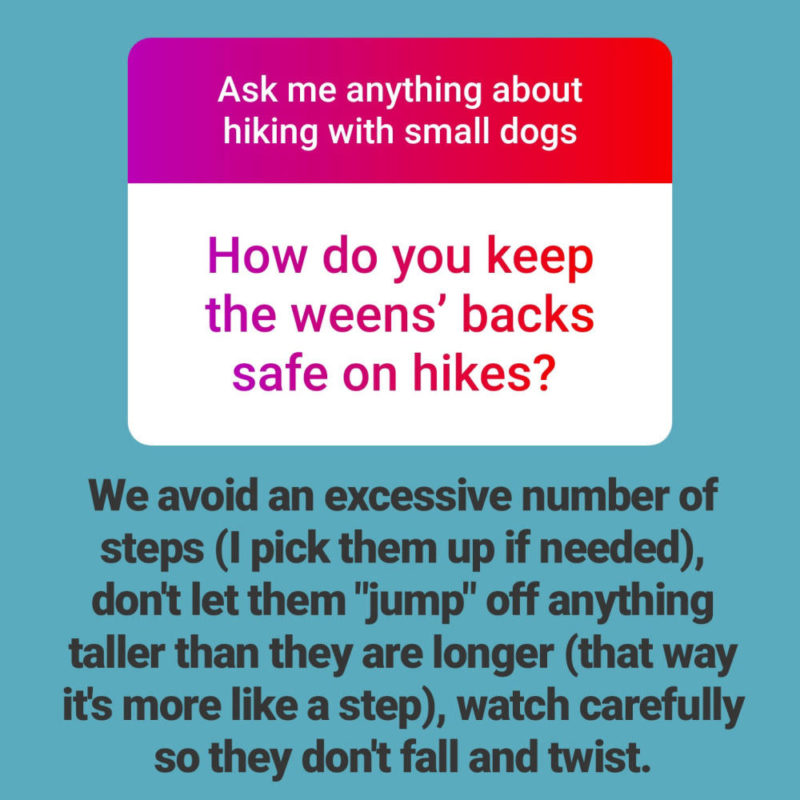


We avoid an excessive number of steps by either not hiking trails that I know have a lot or by carrying them up and down the stair section of the trail.
I also don’t let them jump of anything much taller than they are long. I find that they tend to treat it like a big step that way instead of jumping down.
If a ledge is taller than that, I will lift them going down.
I’m not so worried about going up because the impact when jumping to a surface higher than they are currently puts significantly less impact on their muscles and joints.
Along those lines, I lift them up and down any time there is a situation where I think it’s likely they could fall and twist, which is one of the worst things for a Dachshund’s back.
I will note that they are quite capable of scrambling up ledges and rocks and otherwise staying on their feet. I rarely have to lift or carry them.
A strong core will also go a really long way to protecting a dog’s back. Our rehab veterinarian recommended these exercises to keep Gretel’s back strong after she was diagnosed with IVDD.
Q: “How long are dog’s feet ok in the snow?”
That depends on the dog, the ambient air temperature, the length of time your dog will be walking in the snow, and whether your dog has furry feet the snow can stick to.
I’ve found that if the air temperature is above 30F, my small dogs Summit and Gretel can hike in the snow for at least a few hours.
The main key to them staying comfortable is to keep their body core extra warm by wearing a jacket.
One of the ways that dogs dissipate body heat is to push it out through their feet. If their body temperature is slightly above normal, it’s likely that their feet will be able to stay warm enough on their own.
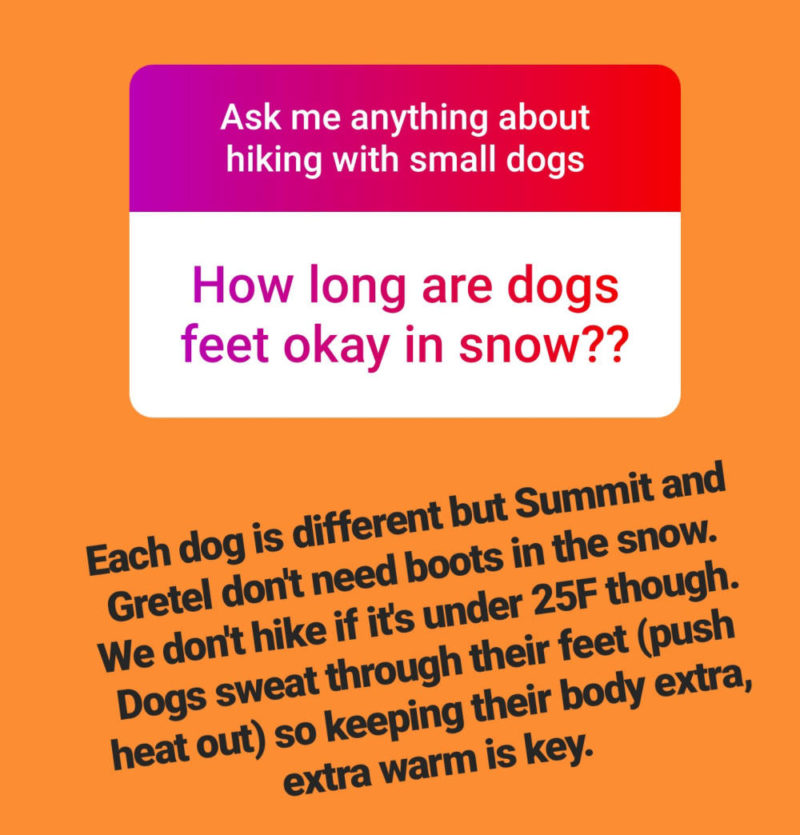


However, Summit and Gretel don’t have hairy feet so powdery snow doesn’t stick to them.
We also don’t hike in winter if the temperature is below 25F.
I generally don’t recommend dog boots for hiking but they are sometimes necessary in the winter. Read my article Does Your Small Dog Need to Wear Boots in the Snow? to help determine whether your dog needs them or not.
Q: “I have one pup who gets her pads torn or worn easily. Any suggestions?”
We’ve rarely had foot problems so I don’t have a great go-to solution.
I make sure to walk my dogs regularly on hard surfaces to toughen up their foot pads.
I also put Musher’s Secret paw balm on their feet if we’re hiking in snow or where I think they need some extra protection.
I’ve also heard good things about Tuff-foot but haven’t tried it.
Q: “I have a Dachshund-Jack Russel mix. I’m scared he’ll run off a cliff trying to chase something. Is my fear real?”
Yes, your fear is real.
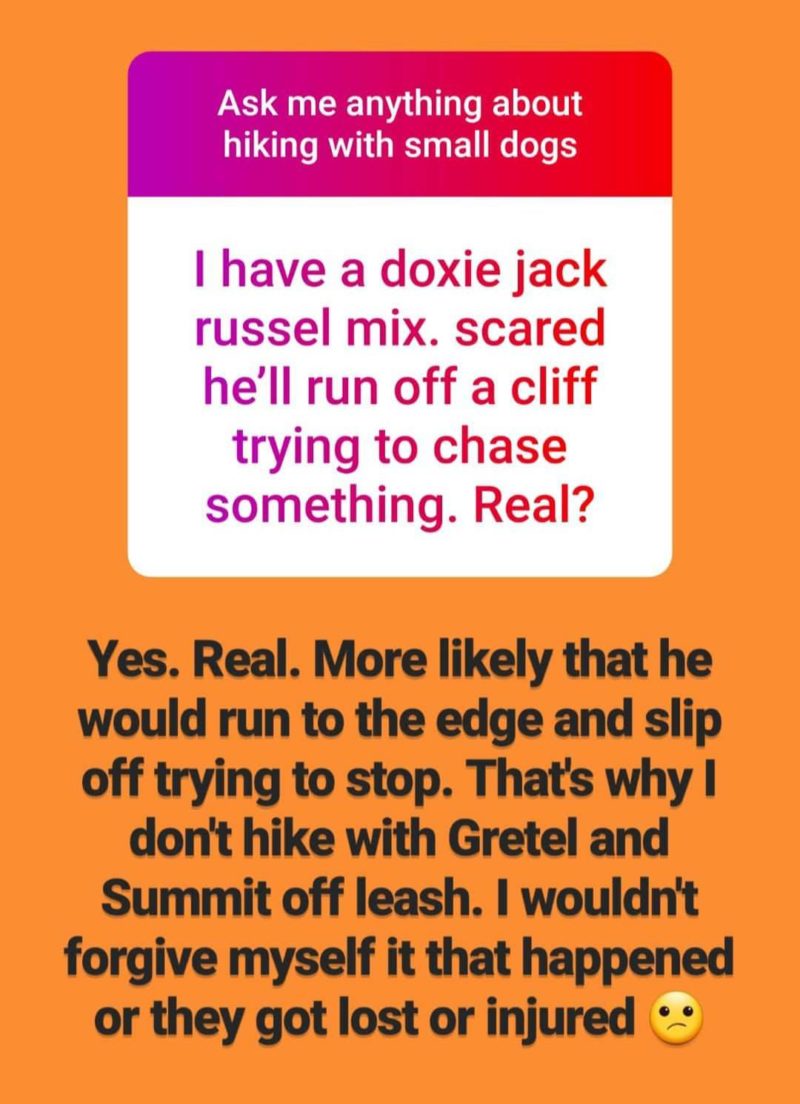


Most dogs, even if they were not bred to hunt like both a Dachshund and Jack Russel were, can’t resist chasing a tasty smelling, fast moving squirrel.
It’s completely possible they could chase one to the edge of a cliff.
While they likely wouldn’t jump off the cliff after it, many cliff edges have loose rock and vegetation on them so a dog could slip off the edge.
Q: “My dog hates riding in the car. Any suggestions?”
The issue is usually because a dog gets carsick or is scared of the car (or both).
It can usually be overcome with positive conditioning and car sickness remedies to calm the dog and settle their stomach.
My Article When You Want to Go Hiking but Your Dog Hates the Car discusses how to tell the difference between motion sickness or anxiety and what to do about it.
Q: “How far can you hike with your small dog?”
This is another question I received several times in different forms.



Summit is a puppy so this is her first hiking season. The longest hike she’s been on was just over 5 miles. She shows no signs of getting near her mileage limit.
The longest I’ve hiked in one day with Gretel was 11 miles but it was part of a 3-day, 30-mile backpacking trip.
Small dogs are more capable that most people think. Check out my article How Far Can My Small Dog Hike for more information about appropriate distance.
Q: “Are all hikes safe for small dogs?”
Personally, I’ve very rarely encountered a trail that was too difficult for my small dogs.
Gretel, and my first Dachshund Chester, even hiked one of the steepest trails in the Seattle area. Twice.
However, every dog is has a different fitness level and athletic talents. For that reason, this is a complicated question.
For sure, any hike classified as a “scramble“, or over a Class II hike, is probably approaching too dangerous for any dog.
There are also other considerations, besides terrain, that can make a hike dangerous for dogs.
These things could include:
- Trails that skirt high ledges or steep drop-offs
- Trails that are known to attract a high number of poisonous snakes or dangerous wildlife
- Hiking any trail on a day that is too hot (we don’t hike if it’s over about 85F)



Q: “Are there any dog breeds you know of that shouldn’t hike?”
Since I hike with my Dachshunds, and many people think they can’t or shouldn’t hike, I’m hesitant to call out any breed of dog that “shouldn’t” be out on the trails. We’re all about breaking stereotypes after all.
I’ve seen dog breeds out on the trail that I didn’t expect made good trail dogs and had my beliefs challenged.
With that being said, it’s my understanding that one needs to be extra cautious if hiking with a short-nosed (brachycephalic) dog breed (like pugs and bulldogs) as they can encounter breathing problems.



The most important thing is to know your own dog and respect their limits.
Here is a list of small dog breeds that make the best hiking companions.
Q: “Do you ever carry them in a backpack? We haven’t seen one that would safely support a Dachshund’s back.”
Ah… the search for the golden unicorn.
I’m aware of almost every backpacks and carrier out there designed for carrying small dogs and have tried several.
The fact is that an ideal one for carrying Dachshunds doesn’t exist. One is kind of left choosing between the lesser of “evils” if they need to carry their pup.
Check out my list of dog backpacks that are the best options in my opinion.
Q: “How do you know when it’s too much and they are too tired?”
There are several ways you can tell if your dog is getting pushed to their limits and getting tired.
Signs can include:
- Starting to walk slower
- Lagging behind
- Excessive panting
- Flopping down on the trail
- Limping
For more details, please read my article about how to tell if your dog has had enough hiking for the day.
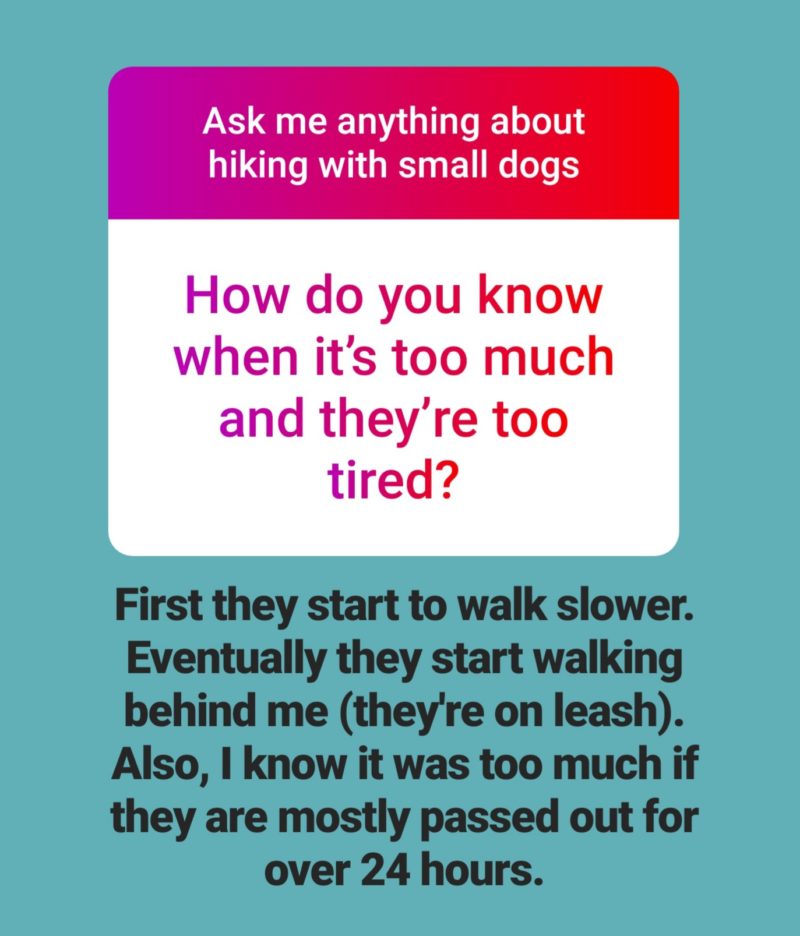


Q: “I live in rattlesnake and mountain lion country. Any precautions you take regarding wildlife?”
I didn’t have detailed recommendations for this question because we only recently moved to an area that has mountain lions and rattlesnakes.
We also live in a State where Grizzly Bears are uncommon and black bears are unlikely to attack.
The general precautions I take are:
- Hike with my dogs on leash so they can’t stray too far (and look like prey) or stick their nose in holes without me knowing
- Know where rattlesnakes are likely to be and keep an vigilant eye and ear out for them
- Remember to try and look as big and scary as I can, and slowly back away, if we encounter a mountain lion
- Watch for all wildlife and try to keep my dogs from barking at them and irritating them or stressing them out
When I shared that I was new to dealing with rattlesnake issues, a couple readers messaged us to offer their tips:
- Make a lot of noise wherever you go to let snakes and wildlife know you are coming (so hopefully they will wander off)
- In snake territory, step over obstacles like rocks and downed logs before your dog does so you can check out the area first and hopefully scare it off before your dog startles it



Q: “Do you have any hiking or camping gear for small dogs that you would recommend?”
I’ve been hiking with my Dachshunds for over 15 years and camping with them for almost as long. Throughout the years I’ve learned a lot about what gear works best for small dogs and for us specifically.
Some things that I always bring with us when hiking are:
If you want more details about our recommendations, please check out these articles:
Q: “I have been using the retractable leash. What would you recommend?
Personally, I don’t recommend retractable leashes. Especially not for hiking.
I admit I used one with my dog Chester for a long time but that was before I was aware of the dangers, and the dog behavior issues (like running up to another dog without permission), they can invite.
We use a 6-foot static leash.
My favorites are made from Biothane (coated webbing – “vegan leather” and waterproof) or climbing rope.
If your questions about hiking with small dogs, or Dachshunds specifically, wasn’t answered here, please ask in the comments below.



<!–
–>
source http://www.luckydogsolutions.com/17-of-your-questions-about-hiking-with-small-dogs-answered/

No comments:
Post a Comment